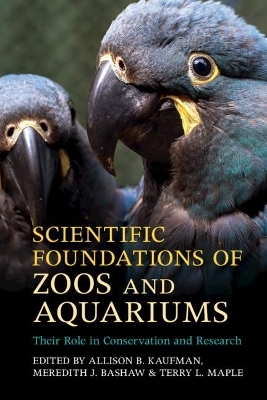
Scientific Foundations of Zoos and Aquariums
Cambridge University Press (Verlag)
978-1-316-64865-0 (ISBN)
In the modern era, zoos and aquariums fight species extinction, educate communities, and advance learning of animal behaviour. This book features first person stories and scientific reviews to explore ground breaking projects run by these institutions. Large-scale conservation initiatives that benefit multiple species are detailed in the first section, including critical habitat protection, evidence-based techniques to grow animal populations and the design of community education projects. The second section documents how zoos use science to improve the health and welfare of animals in captivity and make difficult management decisions. The section on saving species includes personal tales of efforts to preserve wild populations through rehabilitation, captive breeding, reintroduction, and public outreach. The concluding section details scientific discoveries about animals that would have been impossible without the support of zoos and aquariums. The book is for animal scientists, zoo professionals, educators and researchers worldwide, as well as students of zookeeping and conservation.
Allison B. Kaufman is Research Scientist with the Department of Ecology and Evolutionary Biology at the University of Connecticut, and Adjunct Professor in the Department of Psychology at the University of Connecticut at Avery Point. Meredith J. Bashaw is Professor in the Department of Psychology at Franklin and Marshall College, Pennsylvania. Terry L. Maple is Smithgall-Watts Professor Emeritus at the Georgia Institute of Technology and Professor-in-Residence at Jacksonville Zoo and Gardens. He was previously CEO of Zoo Atlanta and the Palm Beach Zoo, and the elected president of the Association of Zoos and Aquariums.
Introduction Michael Hutchins, Robert J. Wiese and Brandie Smith; Part I. Programs and Initiatives: 1. Evolving approaches to zoo-based conservation Corinne J. Kendall and Richard A. Bergl; 2. Protecting an underwater rainforest: freshwater science in the Southeastern United States Anna L. George, Joshua R. Ennen and Bernard R. Kuhajda; 3. Headstarting as a conservation strategy for threatened and endangered species Patrick Thomas, Donal M. Boyer, David A. Oehler, Scott Silver and Lou Perrotti; 4. Strategic gene banking for conservation: the ins and outs of a living bank Rebecca J. Hobbs, Justine K. O'Brien and Rebecca E. Spindler; 5. The environmental education program at São Paulo Zoo (Brazil): perspectives and experiences for wildlife conservation Kátia Gisele de Oliveira Rancura, Camila Martins and João Batista da Cruz; 6. Conservation and education through dolphin research and eco-tourism Kathleen Dudzinski and Mary Ellen Mateleska; Part II. Captive Care and Management: 7. Lear´s macaw, Anodorhynchus leari, ex situ breeding program at São Paulo Zoo Fernanda Junqueira Vaz Guida, Regiane Vieira de Paiva Morais and Angélica Midori Sugieda; 8. Measuring welfare through behavioral observation and adjusting it with dynamic environments Jason V. Watters, Bethany L. Krebs and Eridia Pacheco; 9. Empowering zoo animals Stephanie M. Allard and Meredith J. Bashaw; 10. Transforming the nutrition of zoo primates (or how we became known as Loris Man and that Evil Banana Woman) Amy Plowman and Francis Cabana; 11. Tough questions, complex answers: American zookeeper responses in a nationwide survey about culling David M. Powell and Matt Ardaiolo; Part III. Saving Species: 12. Fly away home: a collaborative program to return rehabilitated black cockatoos to the wild in Western Australia Anna Le Souëf, Simone Vitali, Rick Dawson, Jill M. Shephard and Kristin S. Warren; 13. Back into European wildlife: the reintroduction of the northern bald ibis (Geronticus eremita) Johannes Fritz, Markus Unsöld and Bernhard Völkl; 14. The thin green line: medical considerations in fighting extinction of the Houston toad Lauren L. Howard and Paul S. Crump; 15. Condor conservation comes home to roost: the Santa Barbara Zoo's story Estelle A. Sandhaus and Rich Block; 16. Saving the black-footed ferret from extinction: in theory and practice Rachel Santymire; Part IV. Basic Research: 17. 'Largest breeding colony outside of Australia': linking koala ex situ and in situ research Jennifer R. Tobey; 18. Comparative cognition research in zoos Bonnie M. Perdue; 19. Learning about dolphins: an era of discovery in managed care Holli C. Eskelinen, Jill L. Richardson and Kelley A. Winship; 20. Contributions of zoo-based reproductive research to marine animal conservation Justine K. O'Brien, Karen J. Steinman, Gisele A. Montano and Todd R. Robeck; 21. Studying play in zoos and aquariums Sabrina I. C. A. Brando and Gordon M. Burghardt; 22. Krogh's principle and why the modern zoo is important to academic research Joseph R. Mendelson, III, Gordon W. Schuett and Dwight P. Lawson; 23. Does research have a place in the zoological garden? Terry L. Maple and Sally L. Sherwen; 24. Conclusion: cultivating science in world zoos and aquariums Meredith J. Bashaw and Terry L. Maple.
| Erscheinungsdatum | 02.03.2019 |
|---|---|
| Zusatzinfo | Worked examples or Exercises |
| Verlagsort | Cambridge |
| Sprache | englisch |
| Maße | 151 x 228 mm |
| Gewicht | 1110 g |
| Themenwelt | Naturwissenschaften ► Biologie ► Limnologie / Meeresbiologie |
| Naturwissenschaften ► Biologie ► Ökologie / Naturschutz | |
| Naturwissenschaften ► Biologie ► Zoologie | |
| ISBN-10 | 1-316-64865-6 / 1316648656 |
| ISBN-13 | 978-1-316-64865-0 / 9781316648650 |
| Zustand | Neuware |
| Informationen gemäß Produktsicherheitsverordnung (GPSR) | |
| Haben Sie eine Frage zum Produkt? |
aus dem Bereich


